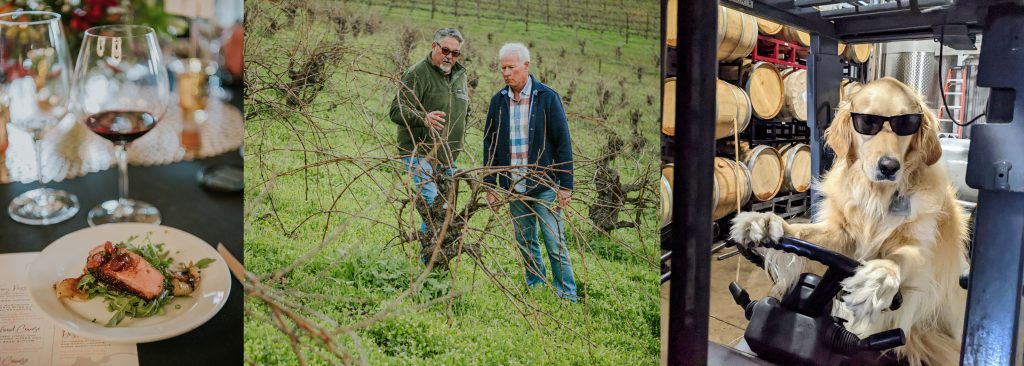February 23, 2023
AFTER THE HARVEST
The Life of a Winery When Crush is Crushed
By Alan Goldfarb
“It’s like the football season. You prepare for three months – and then you do all the work. And then you’re organizing for the next year.”
– Defensive Tackle Scott Stelzle, Brockport State
– Winemaker Scott Stelzle, Cordant Winery
If you thought that after football, I mean harvest season, at a winery it means the work is finished, the story here at Cordant keeps evolving through the entire year. To paraphrase singer Jackson Brown: You pack it up – and then you do it all over again.

So, what goes on at Cordant after the grapes from its various vineyards up and down the Central Coast, are picked and brought into the winery? What happens after all that fruit is crushed and put into fermentation tanks and then into oak barrels?
“We prep the wines and then we put ‘em away,” says Stelzle, the 20-year winemaking veteran, who recently completed his first full harvest at Cordant. “The minute harvest is over we work on last year’s wines; and we’re preparing for another bottling.”
Putting wine in bottles occurs three times a year at Cordant – in January, April and August. (Sidebar…interestingly, it takes about 1-2/3 seconds to fill one bottle, insert a cork, press a top capsule, attach a label, and put the wine in a box (21 seconds per case) on Cordant’s bottling line, or 180 cases per hour.)
Then there are decisions, such as when to release Cordant’s multi-portfolio of wines to its consumers? Stelzle, who has been Cordant’s winemaker for 1½ years, although he had his own winery in Paso for two nearly decades, says he and owner David Taylor “are way out in front of making all the decisions” they’ll have to decide during the year.
Those conclusions, in addition to when to bottle, and when to begin distributing their various wines, is a crucial one: deciding on optimum blends for their wines from their various vineyard sources.
Toward that end, Stelzle explains that he and his crew go from barrel to barrel in the cellar, “anticipating what those wines could be.” To help them do that, they’ll take samples from 700 liters “of this” and 900 liters “of that”; and then they make mini-mock-ups of various blends to determine which formulations work “best” and which will then go into the final compilations.
One of their wines – a 2022 Pinot Noir, in what is shaping up to be a great vintage, despite weather-related vineyard challenges during harvest – is from the renowned Bien Nacido Vineyard in the Santa Maria Valley. While Cordant has sourced Chardonnay from the famed vineyard, the ’22 Cordant Bien Nacido Pinot Noir will be its inaugural release. Everyone at the winery, with much anticipation, is looking forward to the day the wine is released.
“I lay in bed at night thinking about it,” says Stelzle. “What’s it going to taste like? Is it going to be what I hope it’s going to be? With a new vineyard, it literally keeps me up at night.”
As one can see, the life of a winery is in constant motion, all year long; although now the team is not working 12-hour (or more) days which Cordant’s crew immerses themselves in regularly for a couple of months during crush. “But,” ensures Scott, “we’re willing to put in that labor as it’s the only way to meet our goals with our wines.”
In addition to cleaning and maintaining all the winery’s equipment, Cordant is also in the midst of orchestrating a tasting room renovation and upgrades, which will include large maps on the walls featuring the various vineyards from where Cordant sources its grapes.
Post-harvest is also a time to put marketing plans for the ensuing 12-to-24 months into place.
“We have time during this period of the year to be in the marketplace. Now, we can lift our heads up and hone the business side,” says Taylor, whose son Evan – Cordant’s brand director – seems to be on the road constantly, presenting the wines in various cities around the country.
Additionally, this year, some of the Cordant team will be spending time in Europe, visiting several wine regions in Italy, Spain and France.
“It’s all about keeping your palate acute. You don’t want to end up with a ‘winery palate’”, offers the winemaker, expressing the need to taste other types of wines instead of only concentrating on Cordant’s. Doing so would narrow the scope of what is available and limits the possibilities of what can be achieved and expanded upon.
“Tasting wines from others makes for better winemaking, when you taste wine from all over,” asserts Stelzle. “A chef that only eats in his or her restaurant, is where I don’t want to eat. Going to Europe hones my wine skills. We can never know enough about wine.”
**************************
Alan Goldfarb is a longtime wine journalist. His work has been published by The Wine Spectator, Wine Enthusiast, Decanter Magazine, Alta Journal of California, and The Verge, among hundreds of others. Additionally, he is now the publicist for Cordant Winery, through his All Media Winery Solutions agency.
